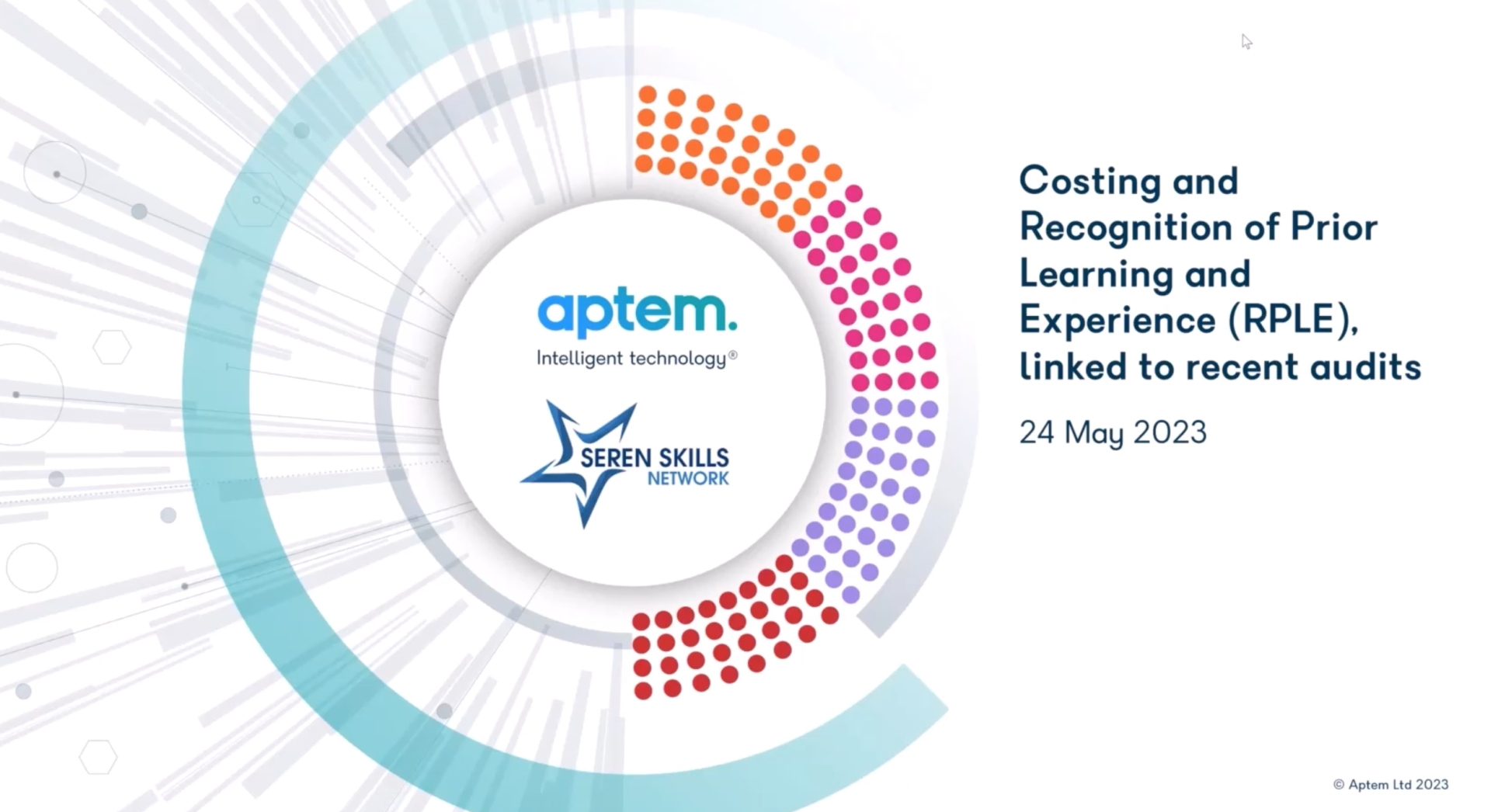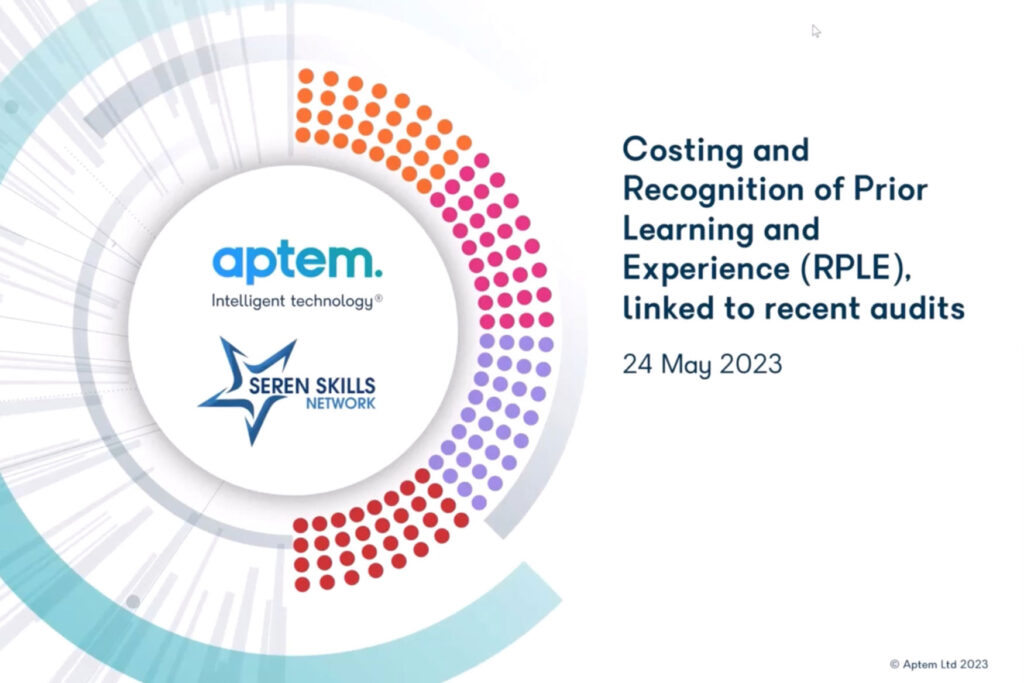Last month, Patrick Tucker, Director of Corporate Strategy, and Hannah Lloyd, Operations Director at Seren Skills were delighted to host a session for Aptem that explored the challenges providers face in relation to RPLE, as identified in recent audits. In their presentation, they covered the following.
- What the latest funding rules mean for RPLE?
- How you should be identifying RPLE within your initial assessment?
- Alterations you need to make to your training plan following the identification of prior learning.
- Other factors to consider, including employer contracts and what is eligible/ineligible for funding.

Q and A transcript
The following is a transcript of the questions asked during the webinar, along with the answers provided by product experts. For any further information, do contact your Implementation Consultant, Customer Success Manager or Aptem Support.
With regards to the shortening duration due to training plans, what if we adapt to stretch & challenge the learner, to increase the duration?
As per the answer given on the webinar, the key is to understand your delivery methodology and what it takes to deliver the ‘entire’ Standard with no prior learning.
When a learner changes employer, is a full initial assessment required, or can we just take off funding that has already been claimed?
Yes, a full initial assessment should be completed to ensure compliance and employer involvement, and to demonstrate good practice. Also to fully align to the DfE (ESFA) Funding Rules.
Where a learner has completed part of an apprenticeship with another provider, but we are unsure of the duration they completed with the former provider and we have assessed that there is significant prior learning, can we enrol them on less than a 12 month programme, and can this be recorded as a transfer in?
This question is rather complex and requires clear transparency from the prior training provider. If you are unable to clearly demonstrate prior learning, activity, Off the Job (OTJ) and Training Plan covered, a less than 12 month duration would not be advisable. As per the ILR return you would need the original start date of learning and the UKPRN number of the original provider. Please see the current funding rule P38 and P39 on page 21.
Re 50% in England, do we have to go back over apprentices signed up prior to August 2023, or can we just add that to the new intake for August 2023?
Where possible it would be good to have a new version to add to existing versions and get re-signed. For new cohorts moving forward this must be done.
We do reduce the costs for RPL but cannot reduce the start/end dates, as the knowledge often relates to learning in the middle of the course. How do others account for this and the impact on OTJ hours?
As per the answer given on the webinar, the key is to understand your delivery methodology and what it takes to deliver the ‘entire’ Standard with no prior learning.
Where can we find this document?
Due to the nature of the working papers the best course of action is to make full utilisation of the PDSAT toolkit – Link here
Is their guidance for how experienced as opposed to qualifications should be treated or do you simply have to justify this? If the current employer wants the part of the training that relates who has the final say?
It is a tripartite agreement demonstrating KSB’s and any qualifications must be justified in accordance with the funding rules at the time for that learner. This accounts for RPLE and APL, and also for Higher qualifications.
Are DfE audit questions and documents available easily/online?
Due to the nature of the working papers the best course of action is to make full utilisation of the PDSAT toolkit – Link here
Is Hannah able to provide a full copy of the questions asked by ESFA at audit? Is this example taken from the actual audit working papers for 22/23?
Due to the nature of the working papers the best course of action is to make full utilisation of the PDSAT toolkit – Link here
For learners who have previously enrolled on a standard with a different provider, withdrawn and then been renominated with a new provider, is there a robust way to calculate the funding already received for the standard and consider this in the RPLE calculation for the new enrolment?
If it is a new enrolment with a new provider, you must demonstrate and evidence prior learning and experience / Off-the-Job (OTJ) previously delivered when considering duration and cost. This must be validated and evidenced through clear validation. Note – this is a long answer and may be better explained verbally.
How should we show the profit margin on the costs sheet?
As per the 23/24 funding rules – extract below.
87. The majority of main providers will operate on commercial terms and will expect to create a surplus (profit); a surplus ensures the financial viability of a business and can provide funds for example to fund ineligible costs, improve facilities and services and remain competitive. This is a legitimate approach to take. A surplus (profit) can be made on eligible costs, except for: 87.1. Items that are procured from external sources. For example, if £500 of materials are bought to be used in the delivery of training (e.g. perishable ingredients for catering apprenticeships), additional profit must not be charged on the £500 price of these materials. 87.2. Delivery that is procured from a subcontractor. Note that this only relates to the specific fees charged by that subcontractor; a provider can still cover the costs of managing the subcontractor under the eligible cost of ‘Programme governance, management and administration’. This please note reflects only to Main providers NOT employer providers. P87 page 54.
If the learner is on a 12 month programme and has 5% RPL (Recognition of Prior Learning), is it OK to only reduce the price and not the duration as if we reduced the duration the learner will then not meet the minimum duration?
The learner needs to meet minimum duration to be an eligible apprentice.
